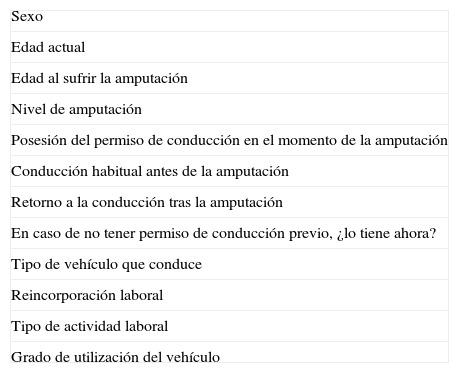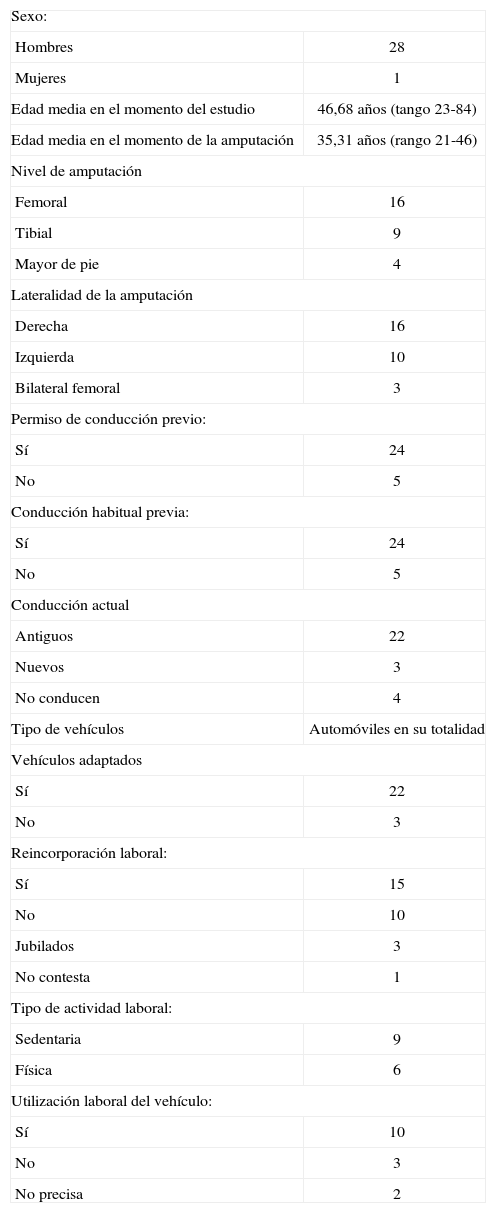Uno de los objetivos de la rehabilitación es la reintegración del paciente discapacitado a las actividades de la vida diaria, entre ellas, la conducción. El objetivo del presente estudio es averiguar qué proporción de pacientes con amputaciones mayores de extremidad inferior de causa traumática retornan a la conducción.
Pacientes y métodoEstudio transversal realizado mediante encuesta telefónica de 29 pacientes afectos de amputación mayor de extremidad inferior, en edad de conducción. Pacientes con amputaciones menores de extremidad inferior y rechazo a participar fueron excluidos. Variables recogidas: sexo, edad actual, edad al sufrir la amputación, nivel y lateralidad de amputación, posesión de permiso de conducción en el momento de la amputación, conducción habitual en el momento de la amputación, retorno o inicio de la conducción tras la amputación, tipo de vehículo, reincorporación laboral, tipo de actividad laboral y grado de utilización del vehículo.
ResultadosContestaron 29 pacientes, 28 hombres y 1 mujer, de ellos 24 conducían habitualmente antes de la amputación. En el momento de la encuesta conducían 25. Todos utilizaban coches adaptados a excepción de 3 pacientes con amputación mayor de pie. Entre los 5 pacientes que no poseían permiso de conducción, o lo tenían de categoría inferior, 3 lo obtuvieron tras la amputación. De los 29 pacientes entrevistados 15 habían retornado a la actividad laboral y de ellos, 10 usaban automóvil en relación con su trabajo.
ConclusionesLa mayor parte de los pacientes amputados de extremidad inferior retornan a la conducción.
One of the goals in rehabilitation of patients with disabilities for daily life activities is, among others, to be able to drive. This study aims to determine the percentage of patients who return to driving after traumatic major lower-limb amputations.
Patients and methodsCross-sectional study by telephone survey of 29 patients with traumatic major lower-limb amputation with driving age. Patients with minor lower-limb amputations and those refusing to participate were excluded. Main variables of gender, current age, age at the time of suffering the amputation, level and laterality of amputation, having a driver's license at the time of amputation, usual driver at time of amputation, return or initiation of driving after amputation, type of vehicle, return to work, type of work activity and grade of vehicle use were also recorded.
ResultsA total of 29 patients, 28 men and 1 woman, answered the interview. There were 24 participants who usually drove before amputation and at the time of the interview, 25 subjects were driving. Most of them drove a car with modifications, except for 3 cases with major feet-amputation. Among the 5 subjects who did not have a driver's license at the time of amputation, or had a license to drive motorbikes, 3 obtained it after the amputation. Out of the 29 patients interviewed, 15 had returned to their jobs and 10 of them needed the car for the normal development of their work.
ConclusionsMost of the patient with traumatic major lower-limb amputations are able to drive again after amputation.
Artículo
Comprando el artículo el PDF del mismo podrá ser descargado
Precio 19,34 €
Comprar ahora








